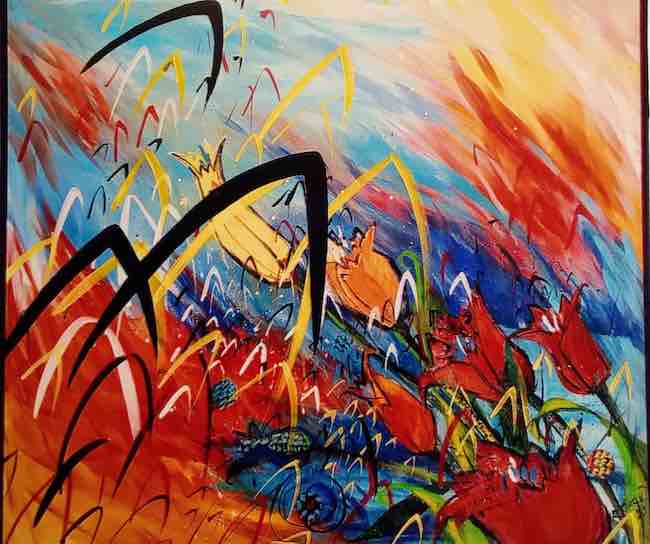Il percorso di conoscenza e approfondimento che ogni artista deve affrontare per trovare il suo canale espressivo in alcuni casi si compie rapidamente permettendo al creativo di incanalarsi fin da subito in quello che sarà il linguaggio che lo contraddistinguerà, in altri invece la predisposizione alla sperimentazione e al desiderio di misurarsi con sfide sempre nuove ed entusiasmanti può divenire invece la costante di un artista, determinando quell’attitudine a modificarsi costantemente per incontrare di volta in volta il mezzo, il materiale e lo stile più affini alla sensazione del momento di creazione. L’artista di cui vi racconterò oggi ha esattamente questo tipo di approccio derivante sia dalla sua esperienza di insegnamento che da un’indole curiosa e vivace che non riuscirebbe a rientrare in un unico schema.
Il trasformismo espressivo è stata una caratteristica che si è manifestata in particolar modo nel Ventesimo secolo, quando cioè il susseguirsi delle nuove correnti pittoriche era rapido e dinamico al punto che alcuni artisti che avevano contribuito a definire le linee guida di un movimento se ne sono poi distaccati modificando completamente il proprio stile pittorico e scultoreo. Il primo tra i grandi sperimentatori del periodo a metà tra fine Ottocento e inizi Novecento fu Paul Gauguin che da un’iniziale adesione alle tematiche dell’Impressionismo si spostò al Postimpressionismo prima e all’Espressionismo poi, dando vita a quella cifra artistica che lo consacrò al mondo. Più avanti, e proprio ispirandosi a Gauguin, Henri Matisse fu inizialmente uno tra i principali teorici della ricerca dei Fauves per poi aderire a un Espressionismo via via più stilizzato ed etereo rispetto alle emozioni intense e a volte angosciose degli altri esponenti del movimento, e infine spostandosi verso un Espressionismo Astratto eseguito con tecnica mista, in particolare con il collage, che esprimeva al contempo un suo avvicinamento alla semplicità della natura nella sua forma più fanciullesca e a un distacco dalla figura umana spesso rea di provocare un distacco proprio dal mondo che la ospita. Pablo Picasso, da un esordio impressionista passò poco dopo a un singolare approccio espressionista contraddistinto dalla monocromia, per poi dare vita al movimento forse più rivoluzionario di tutti, il Cubismo di cui fu fondatore insieme a George Braques e poi, negli ultimi anni della sua carriera e della sua vita, tornò verso uno stile più tradizionale legato alla grafica e soprattutto si dedicò alla realizzazione di ceramiche. Infine Corrado Cagli, esponente della pittura romana del Novecento, che concepiva l’espressione artistica solo come costante e continua sperimentazione di stili differenti e di fusioni tra vari linguaggi che potessero evolvere in qualcosa di nuovo, è passato dall’Espressionismo, al disegno grafico a un Astrattismo in alcuni casi più tendente al Geometrico e in altre invece meno strutturato, più istintivo. Dunque la tendenza a misurarsi con sfide sempre nuove per assecondare una personalità poliedrica e dinamica è stata una caratteristica identificativa di tutto quel gruppo di artisti che si sentiva intollerante a una sola definizione, che non riusciva a concepire il mondo dell’arte senza la possibilità di evolvere e adeguare il proprio stile alle ricerche più innovative tanto quanto all’intento creativo che non doveva necessariamente rimanere uguale a se stesso per essere riconoscibile. L’artista di origini venete Rosina Darù, da molti anni ormai residente a Bolzano, presenta la medesima capacità camaleontica dei maestri poc’anzi citati probabilmente ispirata dalla sua professione di insegnante d’arte alle scuole medie che le ha permesso di misurarsi con diversi approcci esecutivi da cui ha tratto ispirazione per dare vita alle sue opere.
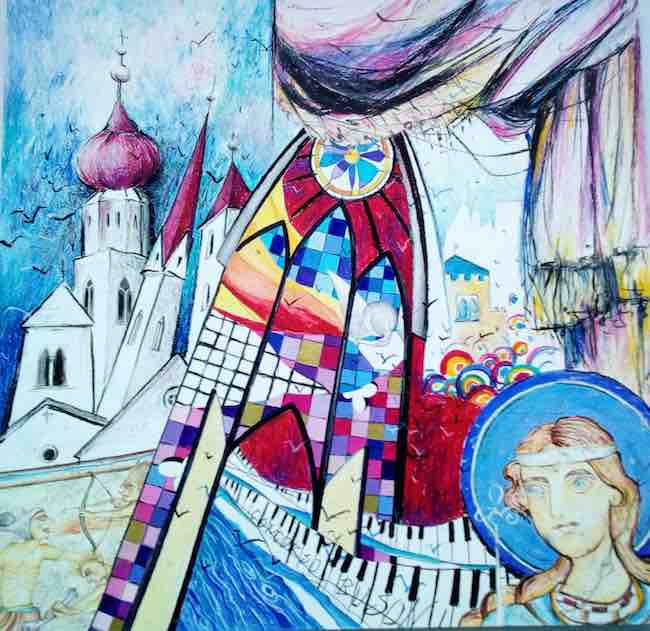
Non solo, confermando la sua natura curiosa e stimolata all’apprendimento, e non unicamente all’insegnamento, ha continuato a seguire corsi per perfezionare la sua tecnica e per apprendere linguaggi espressivi nuovi attraverso cui poter manifestare con maggiore completezza il suo istinto creativo mescolando le proprie conoscenze per dare vita alle sue a volte vivaci altre più delicate opere pittoriche.
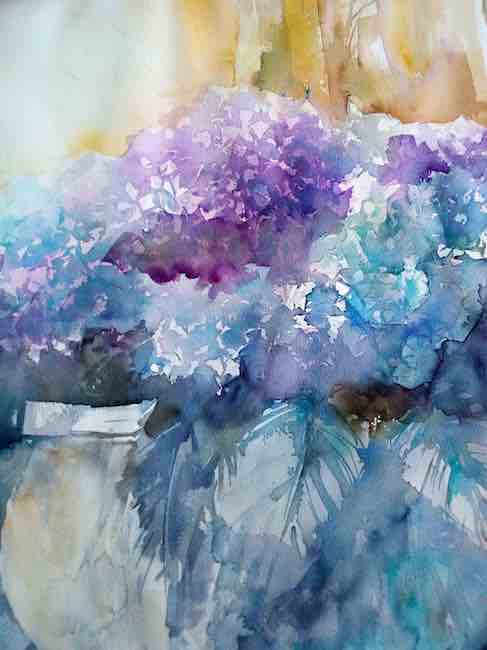
Inizialmente vicina a un Astrattismo Lirico in cui mescola il segno grafico e la figurazione per far emergere dagli sfondi i dettagli che desidera mettere in evidenza, decide di approfondire la tecnica dell’acquarello in cui tutti i contorni sono sfumati, soffici, delicati, quasi a sottolineare la morbidezza della vita e dei soggetti che fa diventare protagonisti dell’opera. Infine, nella fase più recente, Rosina Darù affronta un diverso percorso di apprendimento, quello della forma indefinita dell’Espressionismo Astratto che si accorda perfettamente alla sua indole indipendente e libera che ha contraddistinto il suo intero cammino pittorico e che le permette lasciar fluire le sensazioni senza alcuna delimitazione formale se non quella di un accenno grafico, in trasparenza, che talvolta sente il bisogno di inserire all’interno di quell’indefinitezza espressiva.
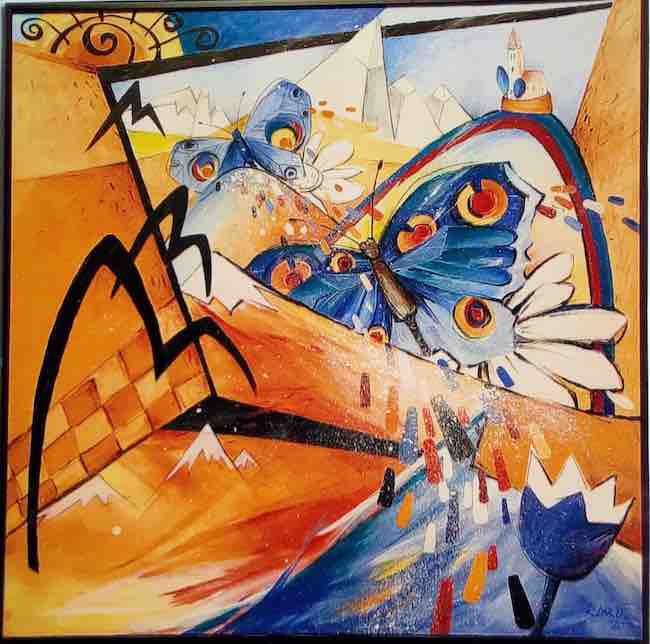
La tela Metamorfosi appartiene alla prima fase della sua produzione, in cui la stilizzazione degli elementi della composizione tendono verso l’astrazione che però ancora sembra resistere alla completa dissoluzione dell’immagine, sia attraverso forme conosciute, anche se semplificate e decontestualizzate alla maniera espressionista, sia attraverso un forte e presente segno grafico che sottolinea e inquadra il concetto protagonista dell’opera, quello della trasformazione identificato con una variopinta farfalla. La gamma cromatica passa dai toni del giallo ocra della cornice che inquadra il soggetto principale, agli azzurri delle ali della farfalla la cui immagine si replica per sottolineare il passaggio da idea a concretezza, esattamente come nell’evoluzione reale di qualsiasi percorso scelto con determinazione dall’individuo.
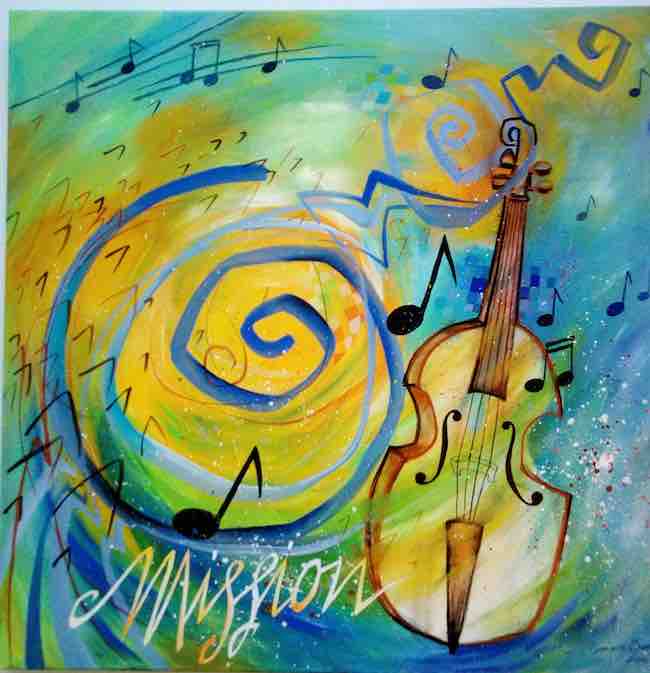
Della medesima serie fa parte anche il dipinto Mission-Omaggio a Morricone in cui non è possibile non avvertire il lirismo, la musicalità di una tela in cui Rosina Darù rende una viola e le note che da essa si sprigionano assolute protagoniste del mondo del grande compositore cinematografico il quale ha reso indimenticabili le colonne sonore di molti film rimasti indelebili nella memoria collettiva. In quest’opera la Mission non è solo quella del titolo di un capolavoro del cinema di ogni tempo ma anche quella stessa di Ennio Morricone, che ha votato la sua intera esistenza a quel morbido mondo di melodie attraverso le quali si è trasformato in un’icona senza tempo.
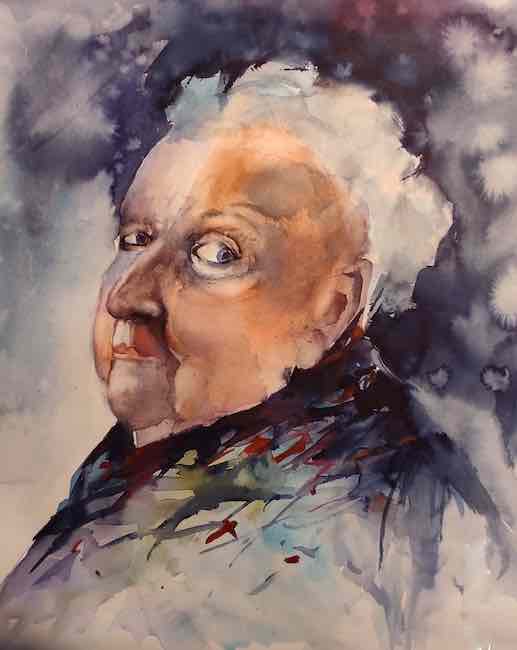
Alla serie degli acquarelli appartiene invece l’opera Sguardo disincantato che sottolinea la tendenza espressionista della Darù poiché il protagonista è sfumato, i suoi tratti sono a volte indefiniti, in particolar modo nei capelli, la definizione dell’immagine si distacca dal Realismo esecutivo per andare verso la decontestualizzazione, l’appiattimento della prospettiva e l’imprecisione dei dettagli, elementi che appartengono incontrovertibilmente all’Espressionismo. Il suo stile nell’uso dell’acquarello è deciso e denso in alcuni dettagli, e poi invece più evanescente e leggero in altri o negli sfondi, per sottolineare l’alternanza dei punti di osservazione e dei dettagli dei soggetti che desidera immortalare. E poi Rosina Darù passa all’Espressionismo Astratto, quello stile libero e immediato attraverso il quale si lascia andare a sensazioni che irrompono sulla tela senza alcun vincolo, senza alcuna delimitazione se non quella della forza del colore che si trasforma in messaggio emozionale, l’unico attraverso cui l’interiorità riesce a fuoriuscire e raggiungere, coinvolgendolo, l’osservatore.
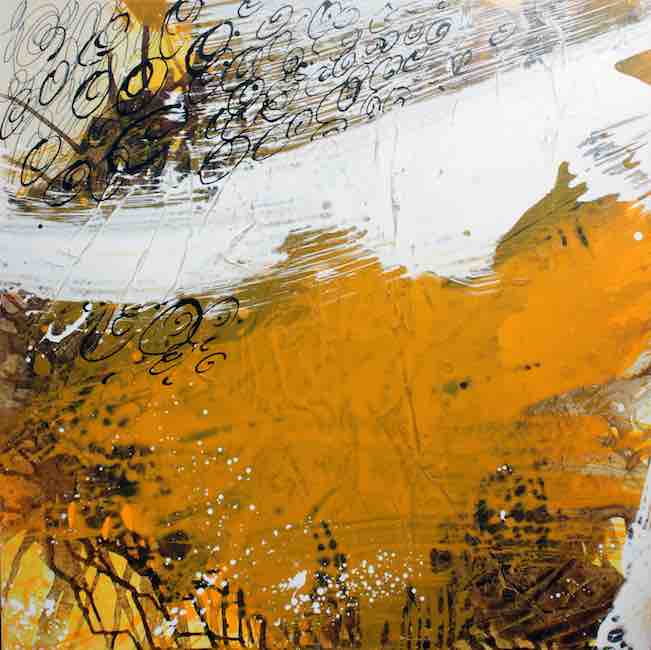
Nell’opera Sopra, il bianco l’artista sembra descrivere una fase di osservazione e di pura sperimentazione sull’accostamento di tonalità che interagiscono, che dialogano tra loro e che inducono a riflettere sui confini spesso delineati nella realtà ma che di fatto tenderanno sempre a compenetrarsi perché non può esistere una delimitazione netta e definita, la quotidianità e la vita sono fluttuanti, fluide; anche in quest’opera non può mancare il tratto grafico che sembra essere una costante dei lavori di Rosina Darù, sia quando lo usa in modo più impalpabile e delicato sia quando invece si fa netto e incisivo come sulla parte superiore del dipinto dove sembra che i riccioli neri siano il susseguirsi delle quotidiane circostanze dell’esistenza.
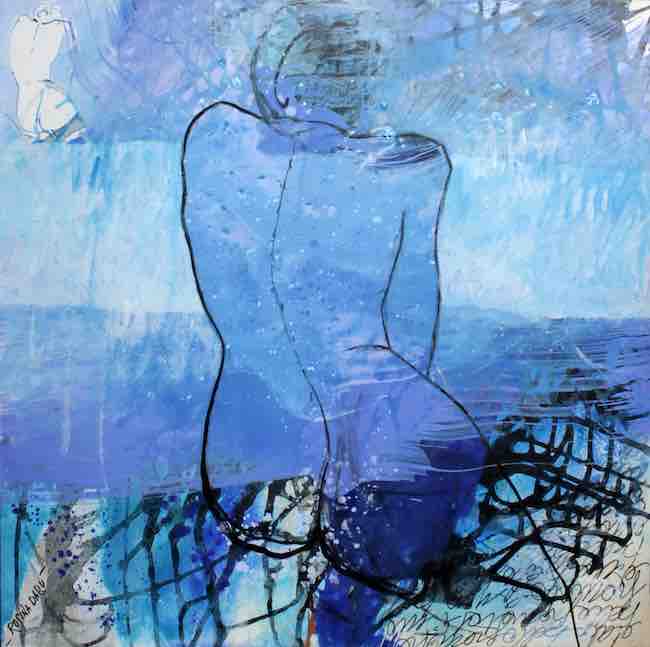
Dopo anni di insegnamento dell’arte nelle scuole medie, Rosina Darù ha avviato il suo personale percorso artistico che l’ha vista partecipare a molte mostre collettive e personali a Bolzano e Padova, dove ha ricevuto anche importanti riconoscimenti. È socia del Club Arcimboldo e dell’Associazione Amici dell’Arte, entrambe di Bolzano.
ROSINA DARÙ-CONTATTI
Email: rosina.daru@gmail.com
Facebook: https://www.facebook.com/rosina.daru
Rosina Darù, hovering between figuration and abstraction to explore the infinite possibilities of art
The path of knowledge and in-depth study that every artist must face in order to find his channel of expression is in some cases rapidly completed, allowing the creative to immediately channel himself into what will be the language that will distinguish him. In other cases, however, the predisposition for experimentation and the desire to measure oneself against challenges that are always new and exciting can become the artist’s constant, determining that attitude of constantly modifying oneself in order to find the medium, material and style most akin to the sensation of the moment of creation. The artist I am going to tell you about today has exactly this kind of approach resulting both from her teaching experience and from a curious and lively nature that could not fit into a single pattern.
Expressive transformism was a characteristic that manifested itself particularly in the 20th century, when the succession of new pictorial currents was so rapid and dynamic that some artists who had helped to define the guidelines of a movement then broke away from it, completely changing their painting and sculptural style. The first of the great experimenters of the period in the mid to late 19th and early 20th century was Paul Gauguin who, from an initial adherence to the themes of Impressionism, moved first to Post-Impressionism and then to Expressionism, giving rise to the artistic style that consecrated him to the world. Later on, and inspired by Gauguin, Henri Matisse was initially one of the main theorists of the Fauves’ research and then adhered to an Expressionism that was gradually more stylised and ethereal compared to the intense and sometimes anguished emotions of the other exponents of the movement, and finally moving towards an Abstract Expressionism executed with mixed media, particularly collage, which expressed at the same time his approach to the simplicity of nature in its most childlike form and to a detachment from the human figure that is often guilty of provoking a detachment from the very world that hosts it. Pablo Picasso, from an Impressionist debut, moved shortly afterwards to a singular Expressionist approach characterised by monochrome, and then gave birth to perhaps the most revolutionary movement of all, Cubism, of which he was a founder together with George Braques, then, in the last years of his career and life, he returned to a more traditional style linked to graphics and above all devoted himself to the creation of ceramics.
Lastly, Corrado Cagli, an exponent of 20th century Roman painting, who conceived artistic expression only as constant and continuous experimentation of different styles and fusions of various languages that could evolve into something new, went from Expressionism to graphic design to an Abstractionism that in some cases tended more towards the Geometric and in others was less structured, more instinctive. Therefore, the tendency to measure oneself with ever new challenges in order to indulge a multifaceted and dynamic personality was an identifying characteristic of that entire group of artists who felt intolerant of a single definition, who could not conceive of the art world without the possibility of evolving and adapting their style to the most innovative research as much as to the creative intent, which did not necessarily have to remain the same to be recognisable. The Venetian-born artist Rosina Darù, who has been living in Bolzano for many years now, displays the same chameleon-like ability as the masters mentioned above, probably inspired by her profession as an art teacher in secondary school, which allowed her to measure herself against different approaches to execution from which she drew inspiration to give life to her artworks. Not only that, confirming her curious and stimulated nature for learning, and not only for teaching, she continued to attend courses to perfect her technique and to learn new expressive languages through which she could manifest her creative instincts more fully, mixing her knowledge to give life to her sometimes lively, sometimes more delicate pictorial works. Initially close to a Lyrical Abstractionism in which she mixes graphic sign and figuration to bring out from the backgrounds the details she wishes to highlight, she decided to delve into the watercolour technique in which all the contours are blurred, soft, delicate, almost as if to emphasise the softness of life and of the subjects that she makes the protagonists of the work.
Finally, in her most recent phase, Rosina Darù tackles a different learning path, that of the undefined form of Abstract Expressionism, which is perfectly in tune with her independent and free nature that has characterised her entire pictorial journey and that allows her to let her sensations flow without any formal delimitation except that of a graphic hint, in transparency, that she sometimes feels the need to insert within that expressive indefiniteness. The canvas Metamorphosis belongs to the first phase of her production, in which the stylisation of the elements of the composition tends towards abstraction, which however still seems to resist the complete dissolution of the image, both through known forms, although simplified and decontextualised in an expressionist manner, both through a strong and present graphic sign that emphasises and frames the artwork’s protagonist concept, that of transformation identified with a multi-coloured butterfly. The chromatic range goes from the yellow ochre tones of the frame underlying the main subject, to the blues of the butterfly’s wings whose image is replicated to put in evidence the passage from idea to concreteness, exactly as in the real evolution of any path chosen with determination by the individual. Also part of the same series is the painting Mission – Homage to Morricone in which it is impossible not to feel the lyricism, the musicality of a canvas in which Rosina Darù renders a viola and the notes that emanate from it the absolute protagonists of the world of the great film composer who made unforgettable the soundtracks of many films that have remained indelible in the collective memory. In this artwork, the Mission is not only that of the title of a cinema masterpiece of all times, but also that of Ennio Morricone himself, who devoted his entire existence to that soft world of melodies through which he became a timeless icon.
To the series of watercolours belongs the work Disenchanted gaze, which underlines Darù’s expressionist tendency as the protagonist is blurred, his features are sometimes indefinite, particularly in his hair, the definition of the image moves away from executive Realism towards decontextualisation, the flattening of perspective and the imprecision of details, elements that unquestionably belong to Expressionism. Her style in the use of watercolour is decisive and dense in some details, and then more evanescent and light in others or in the backgrounds, to emphasise the alternation of viewpoints and details of the subjects she wishes to immortalise. And then Rosina Darù moves on to Abstract Expressionism, that free and immediate style through which she lets herself go to sensations that burst onto the canvas without any constraint, without any delimitation except that of the power of colour that is transformed into an emotional message, the only one through which interiority manages to escape and reach, involving the observer. In the painting Above, the white, the artist seems to be describing a phase of observation and pure experimentation on the juxtaposition of tones that interact, that dialogue with each other and induce reflection on the boundaries that are often delineated in reality but that in fact always tend to interpenetrate because there cannot be a clear and defined delimitation, life is fluctuating, fluid; in this work, too, there is no shortage of the graphic line that seems to be a constant in Rosina Darù’s work both when she uses it in a more impalpable and delicate manner and when it becomes sharp and incisive as on the upper part of the painting where the black curls seem to be the succession of the everyday circumstances of existence. After years of teaching art in secondary schools, Rosina Darù began her personal artistic journey that has seen her participate in many group and solo exhibitions in Bolzano and Padua, where she has also received important awards. She is a member of the Arcimboldo Club and the Friends of Art Association, both in Bolzano.


